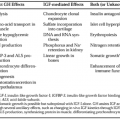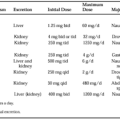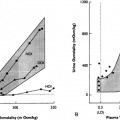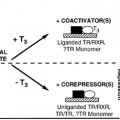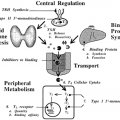RHYTHMS IN THE PITUITARY-ADRENAL AXIS
Part of “CHAPTER 6 – ENDOCRINE RHYTHMS“
Twenty-four-hour profiles of cortisol typical of normal subjects are shown in Figure 6-2, Figure 6-3, Figure 6-4 and Figure 6-6. The patterns of plasma adrenocorticotropic hormone (ACTH) and cortisol variations show an early morning maximum, declining levels throughout daytime, a quiescent period of minimal secretory activity, and an abrupt elevation during late sleep. With a 15-minute sampling rate, ˜15 pulses of ACTH and cortisol can be detected in a 24-hour span. The cortisol profiles shown in the upper panels of Figure 6-2 illustrate the remarkable persistence of the wave shape of the rhythm in the absence of sleep and support the notion that the 24-hour periodicity of corticotropic activity is primarily controlled by circadian rhythmicity. Nevertheless, modulatory effects of the sleep or wake condition have been clearly demonstrated. Sleep onset is reliably associated with a short-term inhibition of cortisol secretion,42,43 and 44 although this effect (which appears to be related to slow-wave stages45) may not be detectable when sleep is initiated at the peak of corticotropic activity (i.e., in the morning13). Conversely, awakening at the end of the sleep period is consistently followed by a pulse of cortisol secretion.46,47 During sleep deprivation, these rapid effects of sleep onset and sleep offset on corticotropic activity are obviously absent, and the amplitude of the rhythm is reduced as compared with normal conditions (see Fig. 6-2).
Stay updated, free articles. Join our Telegram channel

Full access? Get Clinical Tree


